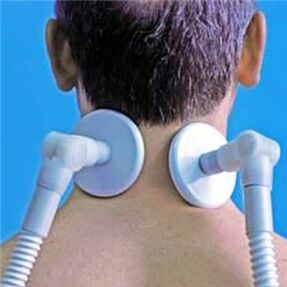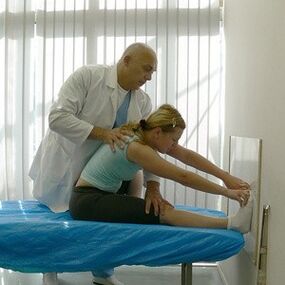Among the many known diseases, most Diseases of the musculoskeletal system, which are mainly associated with physical inactivity, are common. In addition, such problems are inherent not only in the elderly but also in the young. Osteochondrosis of the cervical spine occupies a special place among the pathologies of the musculoskeletal system. What is this disease? What threatens this to its owner? How is it manifested? Are there effective preventive and curative measures?
Diseases of the musculoskeletal system, which are mainly associated with physical inactivity, are common. In addition, such problems are inherent not only in the elderly but also in the young. Osteochondrosis of the cervical spine occupies a special place among the pathologies of the musculoskeletal system. What is this disease? What threatens this to its owner? How is it manifested? Are there effective preventive and curative measures?
Cervical osteochondrosis is a degenerative-dystrophic progressive disease accompanied by deformity of the intervertebral discs. This requires immediate treatment to prevent irreversible pathological changes. Among the various forms of osteochondrosis, cervical pathology ranks second, with only lumbar injury.
Stages of the disease
The development of cervical osteochondrosis occurs in stages:
- The first stage. The intervertebral discs begin to collapse: cracks appear in the annulus fibrosis, the disc loses strength and elasticity, and the height becomes smaller. The result is compression of the nerve roots, accompanied by excruciating pain.
- The second stage. The destruction of the disc continues, causing a small dislocation of the spine. The sensations of pain intensify and become constant. Falling head syndrome can occur, characterized by severe pain that forces its fixed position.
- The third stage. Annulus fibrosus is almost completely destroyed, causing rashes and interstitial hernia. In this case the pain can be reduced since there is no source of pain - cartilage tissue. But the pain syndrome does not completely disappear as the nerve roots become inflamed. Possible sensory disturbances, headache and dizziness, nausea, "lumbago" in the neck.
In the first stage the disease is successfully cured. Irreversible changes occur in the second and third stages. Therefore, complete recovery of the body will be impossible.
Causes of abnormal changes

The vertebrae located in the cervical spine are the most mobile. They have small and weak muscles. This structure of the spine contributes to the development of degenerative disorders. In addition, the cervical region is saturated with nerves and blood vessels, the damage of which not only causes unpleasant symptoms, but also causes serious complications.
The main factors in the development of cervical osteochondrosis are:
- Sedentary lifestyle;
- Prolonged stay in the same condition;
- Metabolic disorders;
- Salt deposits;
- Poor nutrition.
The risk of developing the disease increases:
- Hereditary predisposition;
- Old age;
- Neck injury;
- Prolonged or regular hypothermia of the body;
- Hormonal imbalance;
- Obesity;
- Autoimmune diseases;
- Chronic diseases of the musculoskeletal system.
Symptoms of the disease
The development of cervical osteochondrosis is slow. The symptoms of the disease depend on how diseased the spine is, the degree of damage, and the presence of stretched nerves.
The main symptom of the pathology is pain of varying intensity in the neck, radiating to the back of the head, ears, shoulders, forearms, chest. They are multiplied by their turn and low physical activity.
In addition to pain with cervical osteochondrosis:
- Headaches and heartburn occur;
- Dizziness;
- Darkens in the eyes;
- Hands and feet numb;
- Tinnitus is heard;
- The tongue becomes dull;
- Impaired visual acuity and hearing;
- A sharp turn of the head causes loss of consciousness;
- Is rapid fatigue;
- Coordination is violated.
Several syndromes of cervical osteochondrosis are known:
- Radical - cornea of nerve endings causes severe pain in the neck, radiating to the shoulders, forearms, shoulder blades and lumbar region;
- Heart - The nerve root of the thoracic muscle or phrenic nerve is damaged, resulting in symptoms similar to a heart attack: prolonged pain in the chest (they do not disappear when taking nitroglycerin), which increases with movement and deep breathing;
- Spinal artery - acute pain develops in the back of the head and temples;
- Irritant-reflex - burning pain occurs around the neck, radiates to the shoulders and chest, aggravates coughing and dizziness.
Possible complications
Cervical osteochondrosis can cause significant damage to the body. This is especially dangerous because damage to a deformed spine damages the nerve roots and blood vessels that carry blood to the brain. As a result, the brain does not receive the required amount of oxygen and nutrients, which can lead to disability and even death because heart activity and respiratory function are impaired.
If left untreated, the disease can lead to a variety of complications: vertebral artery syndrome, protrusion, herniated discs, spinal stroke, cerebral ischemia. Often, cervical osteochondrosis causes radiculopathy. In this case, injuries arise on the back of the spine, causing the body to partially or completely lose sensitivity and mobility.
But the most dangerous contraction of the spinal cord, followed by death.
It is therefore important to treat cervical osteochondrosis in a timely manner to help avoid many problems.
Diagnosis

To make a diagnosis, the patient is sent for an instrumental examination:
- Radiography;
- Duplex scanning;
- Ultrasound Dopplerography;
- Computed tomography or magnetic resonance imaging.
Diagnostic measures will provide you with information about the location and extent of the lesion.
First aid
In case the patient experiences unbearable pain, pain relievers (metamizole sodium, etc. ) can be used. If they can not get rid of the pain, then they resort to nonsteroidal anti-inflammatory drugs (diclofenac, ibuprofen, nimesulide). But they can not be taken for a long time, because they have a negative impact on the intestines.
Anesthetic ointments with a warming effect and pepper plaster can effectively relieve pain.
If the patient's limbs are numb, massage and special exercises that activate blood circulation are recommended.
For edema, diuretics are taken.
But all of the above joints have only temporary effects. Therefore, you should not delay a visit to the doctor to avoid the development of complications.
Treatment methods

In order to successfully crown the fight against the disease, it is necessary to:
- Relieving pain syndrome;
- Remove swelling;
- Restore blood flow;
- Muscle corset strengthening;
- Improve tissue nutrition and ensure their regeneration.
Treatment of cervical osteochondrosis should be comprehensive and include:
- Drug therapy;
- Physiotherapy;
- Physiotherapy exercises;
- Methods of alternative and traditional medicine;
- Diet
Drug treatment includes:
- Anti-inflammatory drugs - relieves inflammation, relieves pain, activates blood circulation;
- Muscle relaxants - relieve muscle spasms;
- Chondroprotectors - cartilage tissue repair;
- B vitamins - can be taken orally or intramuscularly.
Physiotherapy procedures are effective in treating cervical osteochondrosis:
- Magnetotherapy;
- Electrophoresis;
- Water therapy;
- Paraffin therapy.
Effective help in the fight against the disease will be provided by non-traditional methods (osteopathy, homeopathy, reflexology, hirudotherapy), massage, manual therapy and special exercises. They stimulate blood circulation, relieve muscle tension, which has a beneficial effect on the general condition of the body. But it is necessary to participate in physiotherapy exercises under the supervision of a specialist, otherwise you can get the opposite effect.
In addition to (but not instead of) drug treatment, it is recommended to use folk remedies.
You should follow a strict diet for 3-4 months:
- Avoid cholesterol-containing products: animal fats, fatty meats;
- Limit consumption of sugar, salt, flour products;
- Exclude alcoholic beverages.
Prevention

An active lifestyle and weight loss are key to preventative measures. Not so important is the diet, which contains the necessary vitamins and minerals.
The sleeping mattress should be firm and the pillow low.
When working in motion, be sure to take a break.
People prone to osteochondrosis should visit an orthopedist periodically.















































